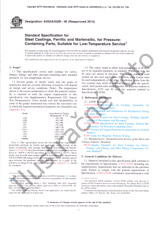Potrebujeme váš súhlas na využitie jednotlivých dát, aby sa vám okrem iného mohli ukazovať informácie týkajúce sa vašich záujmov. Súhlas udelíte kliknutím na tlačidlo „OK“.
ASTM E318-91
Test Method for Uranium in Aqueous Solutions by Colorimetry (Withdrawn 1996)
Automaticky preložený názov:
Skúšobná metóda pre urán vo vodných roztokoch kolorimetricky ( Withdrawn 1996 )
NORMA vydaná dňa 1.1.1991
Informácie o norme:
Označenie normy: ASTM E318-91
Poznámka: NEPLATNÁ
Dátum vydania normy: 1.1.1991
Kód tovaru: NS-46392
Počet strán: 4
Približná hmotnosť: 12 g (0.03 libier)
Krajina: Americká technická norma
Kategória: Technické normy ASTM
Anotácia textu normy ASTM E318-91 :
Keywords:
Colorimetric analysis-water, Uranium content-water, Water-radioactive analysis, uranium in aqueous solutions, by colorimetry, test, ICS Number Code 27.120.30 (Fissile materials and nuclear fuel technology)
Doplňujúce informácie
| 1. Scope |
|
1.1 This test method covers the quantitative determination of uranium in known volumes of aqueous solutions that contain radioactive nuclides. These solutions arise from the processing of irradiated nuclear fuel and from laboratory studies on irradiated uranium. 1.2 The applicability of the test method is limited to solutions that contain a minimum of 30 [mu]g of uranium per sample. It will detect as little as 0.5 [mu]g but with lower precision. Highest precision is obtained when 50 to 75 [mu]g of uranium is in the test sample. At concentrations above 750 [mu]g/mL dilutions must be made. The test method as described is limited to sample volumes of 1 mL or less, but reagent volumes can be scaled to accommodate larger sample aliquots or the sample can be concentrated by evaporation. The only known metal ion interferences are thorium and cerium(IV) when present at molar concentrations equal to or greater than the concentration of uranium. Thorium and cerium(IV) have tolerance limits greater than 1000 if the special extraction and scrub solutions are employed. Cerium(IV) present as a fission product does not interfere because its molar concentration is very low compared to uranium. The tolerance limit (no interference at the 95% confidence limit), expressed as the weight ratio of impurity to uranium, is greater than 1000 for silver, bismuth, calcium, cadmium, cobalt, chromium, copper, iron, mercury, lanthanum, manganese, sodium, nickel, lead, strontium, and zinc. The tolerance limit is greater than 100 for barium, beryllium, potassium, magnesium, and zirconium. Plutonium does not interfere when the weight ratio of plutonium to uranium is less than two. The test method is not designed for solutions containing plutonium in the presence of large amounts of thorium or cerium(IV). The tolerance limit is greater than 100 for the following anions: acetate, borate, bromate, chloride, fluoride, ferricyanide, molybdate, oxalate, phosphate, sulfate, persulfate, thiosulfate, and vanadate. The following anions interfere and have tolerance limits as follows: ferrocyanide 2, thiocyanate 58, and tungstate 12. The tolerance limit for free acid is 16 milliequivalents in the sample aliquot. 1.3 The values stated in SI units are to be regarded as the standard. 1.4 This standard does not purport to address all of the safety problems, if any, associated with its use. It is the responsibility of the user of this standard to establish appropriate safety and health practices and determine the applicability of regulatory limitations prior to use. For a specific precaution statement, see Note 1. |
Odporúčame:
Aktualizácia technických noriem
Chcete mať istotu, že používate len platné technické normy?
Ponúkame Vám riešenie, ktoré Vám zaistí mesačný prehľad o aktuálnosti noriem, ktoré používate.
Chcete vedieť viac informácií ? Pozrite sa na túto stránku.




 Cookies
Cookies
